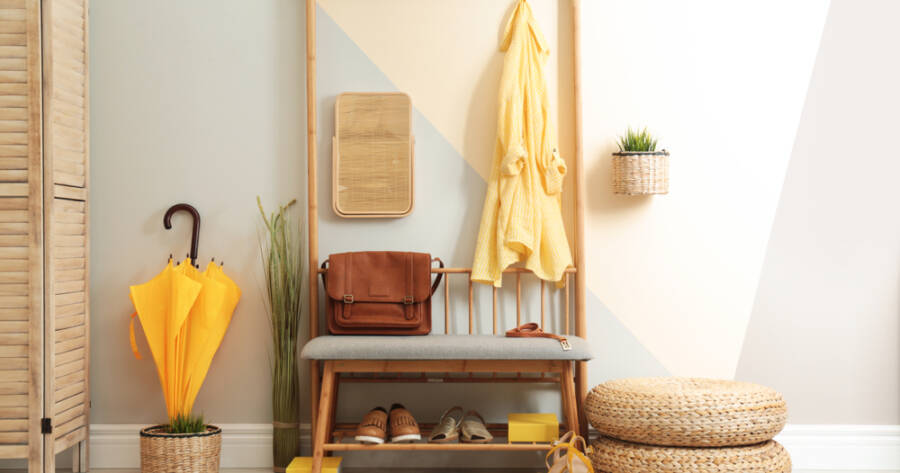Keys, bags, coats, sunglasses, mail–it all seems to land in the same spot the moment you walk through the door. That chaotic entryway clutter is your home’s drop zone, and when left unmanaged, it quickly spirals into a stress-inducing mess. But with a few thoughtful tweaks, this overlooked space can become one of the most functional and stylish parts of your home, keeping your essentials organized and your mind clear.
Identify the Trouble Spot and Define Its Purpose
Every home has a natural drop zone, usually near the front or garage entry. It’s where bags get tossed, shoes pile up, and mail gathers dust. Start by observing what tends to land there most often, and be honest about your habits. Defining what the space needs to do is the first step to organizing it well.
Think about your lifestyle: Do you need a spot for backpacks? A place to sort mail? Somewhere to hang leashes or stash shoes? Once you define its purpose, you can tailor the space to fit your real, everyday needs rather than forcing a Pinterest-perfect setup that doesn’t work for your routine.
Use Vertical Space for Maximum Impact
Drop zones are often in tight or narrow spaces, so using vertical space is key. Wall hooks, pegboards, or floating shelves allow you to store more without crowding the floor. Hang coats, keys, and bags on sturdy hooks to keep items off the ground and within easy reach.
Add a shelf above the hooks for bins or baskets that can hold seasonal items like gloves, sunscreen, or pet supplies. You can also mount a slim magnetic strip for keys or use clipboards for papers and reminders. Going vertical not only saves space, it brings structure and clarity to an area that’s typically a catch-all.
Incorporate Baskets, Bins, and Trays for Quick Sorting
Containment is your best friend in the drop zone. Use small baskets or bins to sort items like mail, receipts, or reusable masks. A tray near the door can hold wallets, watches, or spare change, making it easier to find what you need before heading out.
Labeling your bins can help every household member know where things go–no more guesswork or messy piles. Choose containers that match your décor for a cohesive look, or use color-coding for each family member. When everything has a home, it’s easier to stick to the system and keep clutter from creeping back in.
Add Seating That Works Double Duty
If your space allows, a small bench or stool can make a huge difference in functionality. It gives you a spot to sit while putting on shoes or unloading bags, and many options come with built-in storage underneath. Look for benches with cubbies, baskets, or lift-up lids to stash shoes, umbrellas, or pet gear.
If you’re short on space, consider a wall-mounted fold-down bench or a storage ottoman that tucks out of the way when not in use. Seating makes the space more welcoming while encouraging tidiness—because when it’s easy to sit and organize, people are more likely to do it.
Use a Message Board or Command Center for Daily Flow
A well-placed message board, chalkboard, or magnetic calendar can help your drop zone become more than just a storage space, it can also serve as a communication hub. Use it to jot down reminders, post appointments, or leave notes for family members. It’s a simple addition that brings major functionality.
Add a small corkboard or dry-erase calendar to manage schedules and to-dos. For larger families, a weekly planner with sections for each person can keep everyone on the same page. Keeping this info visible in the entryway helps reduce morning stress and ensures nothing gets forgotten as people come and go.
Style It to Match the Rest of Your Home
Function is important, but your drop zone doesn’t have to look purely utilitarian. Choose colors, textures, and finishes that match the rest of your home so the space feels like a natural extension, not an afterthought. A mirror can make the area feel larger while offering one last glance before you leave the house.
Add a small plant, decorative hooks, or framed art to soften the space and make it more welcoming. When your drop zone looks good, you’re more likely to maintain it. Blending style with function ensures the area serves your needs while elevating the entire entryway.
The Everyday Difference of a Well-Planned Drop Zone
Organizing your drop zone may seem like a small win, but it has a big impact on your daily flow. When everything has a home and clutter doesn’t pile up, mornings feel smoother and evenings more relaxing.
The key is creating a system that fits your real habits, not an idealized version of your home. A well-planned drop zone can transform your entryway from a stress zone into a streamlined, stylish space you’ll appreciate every day.

